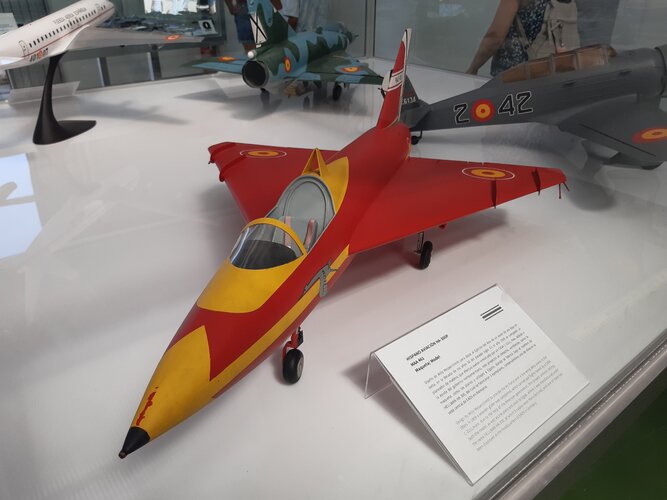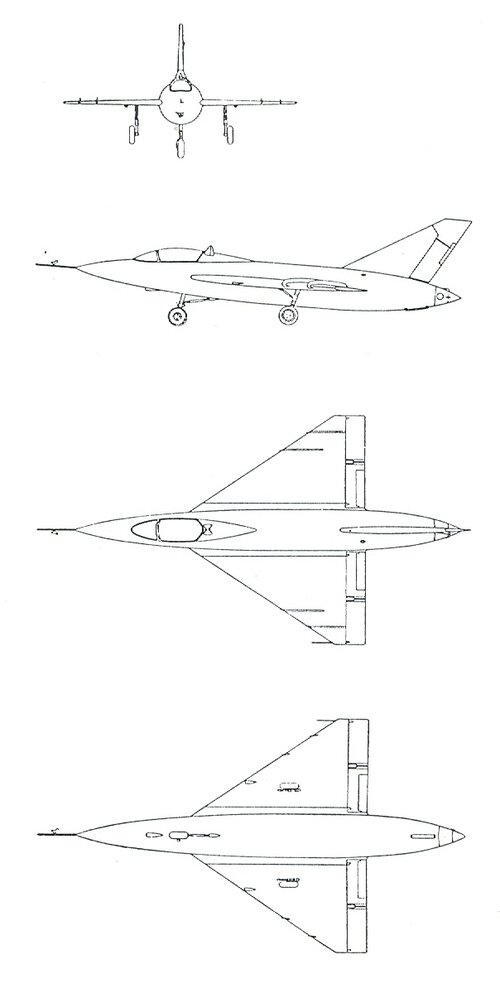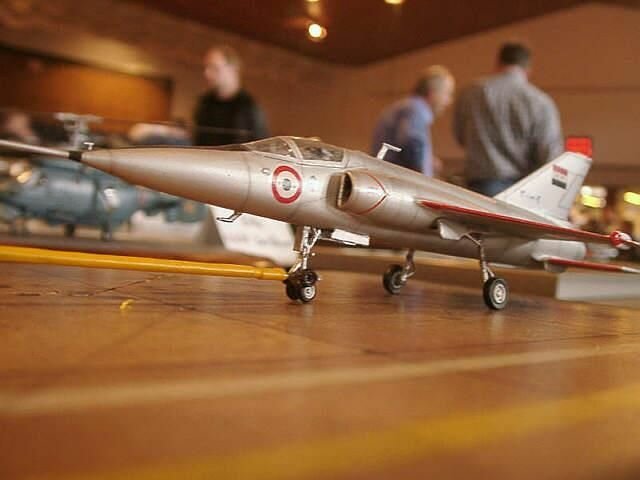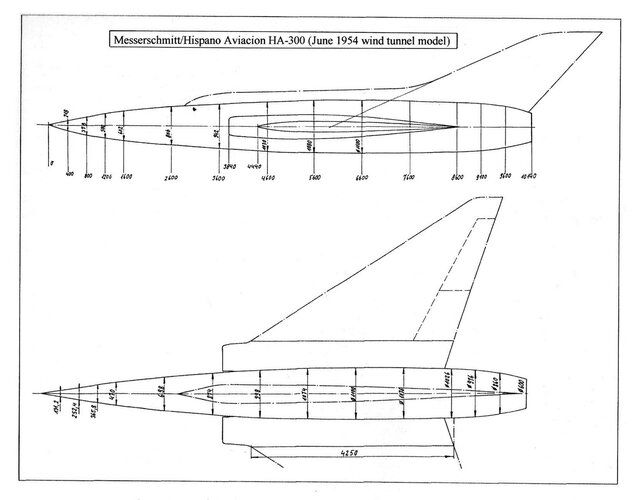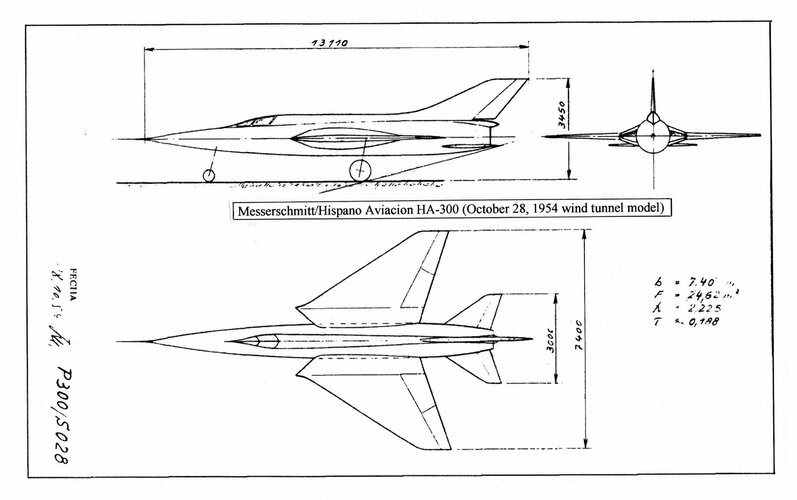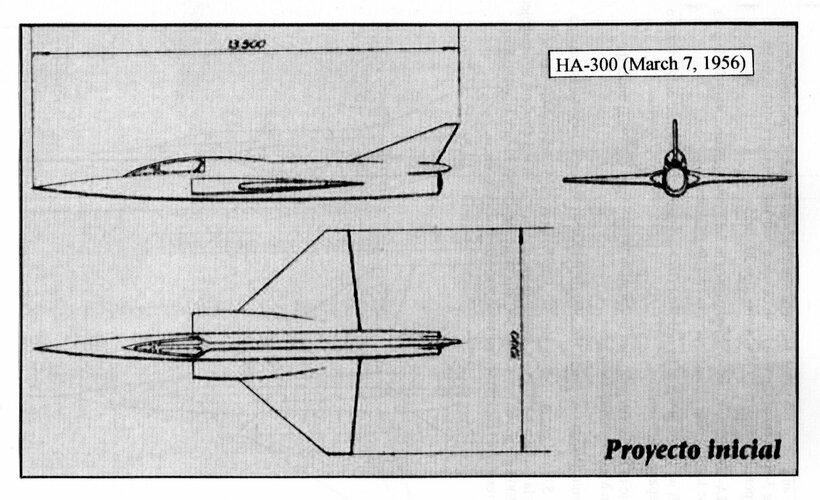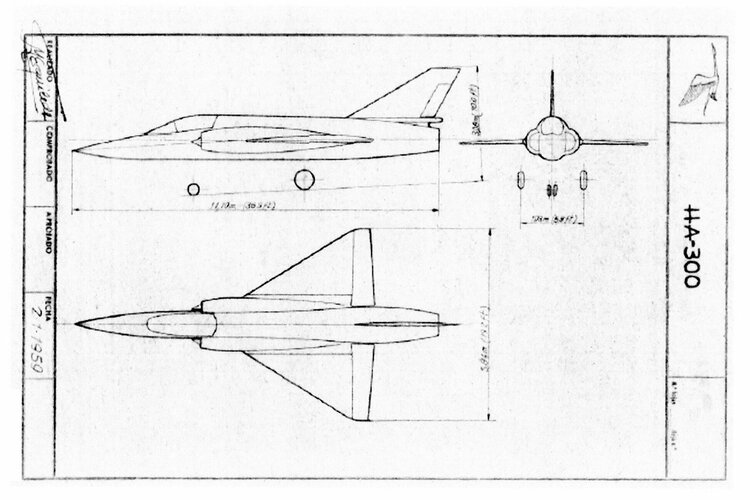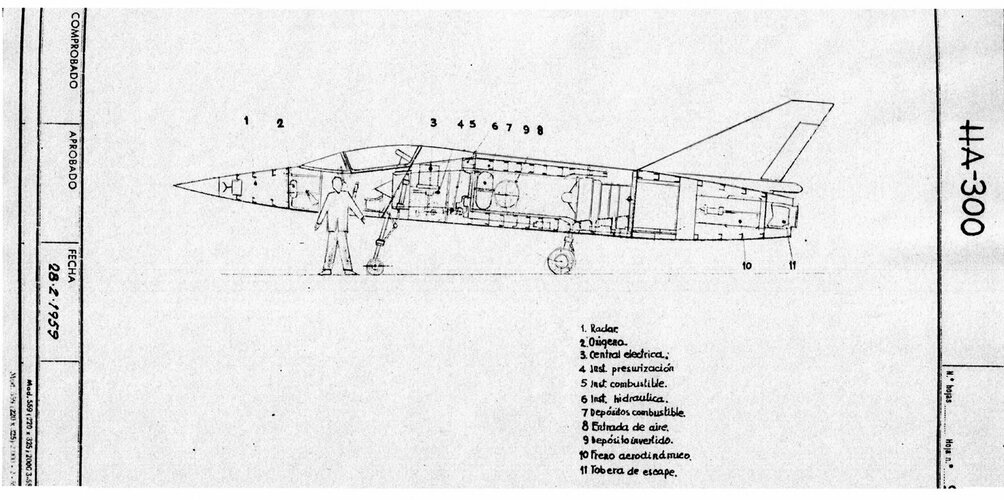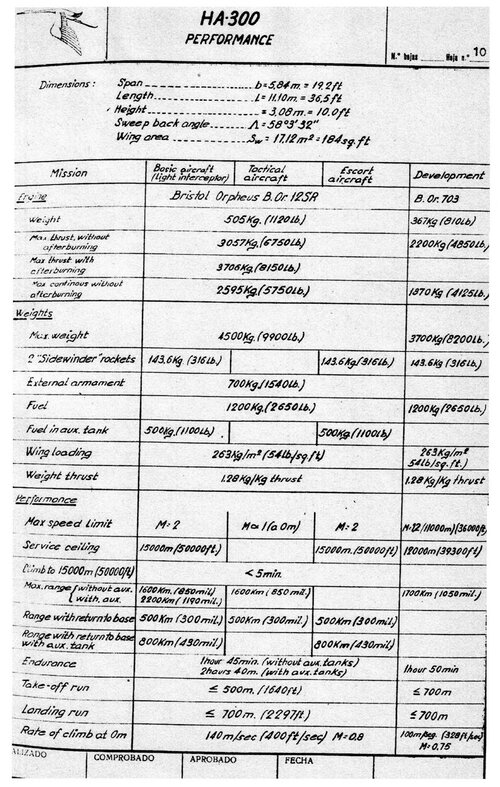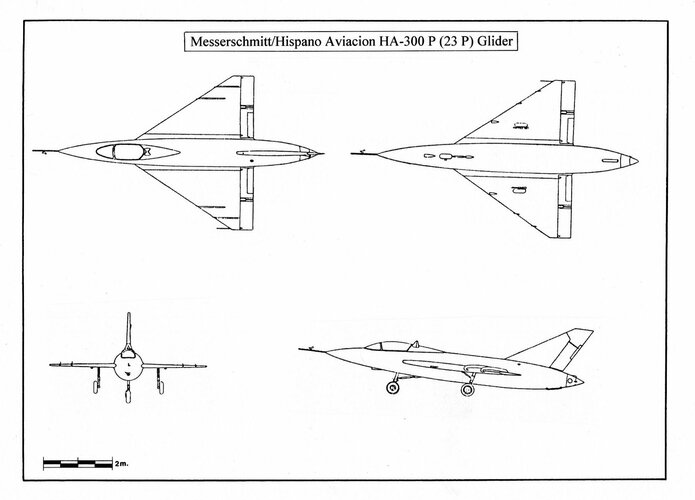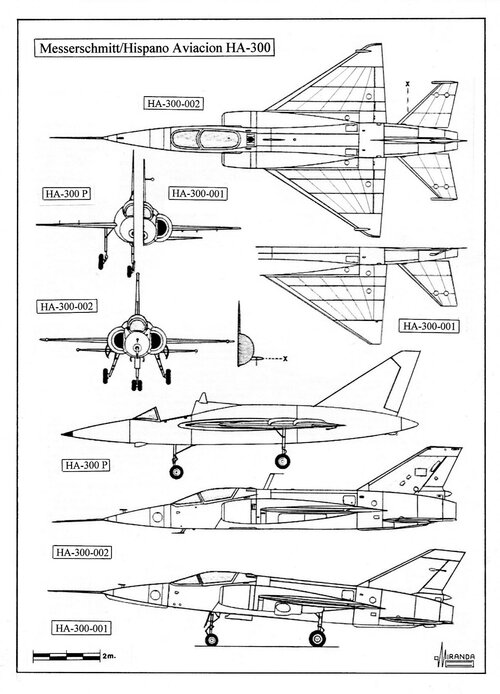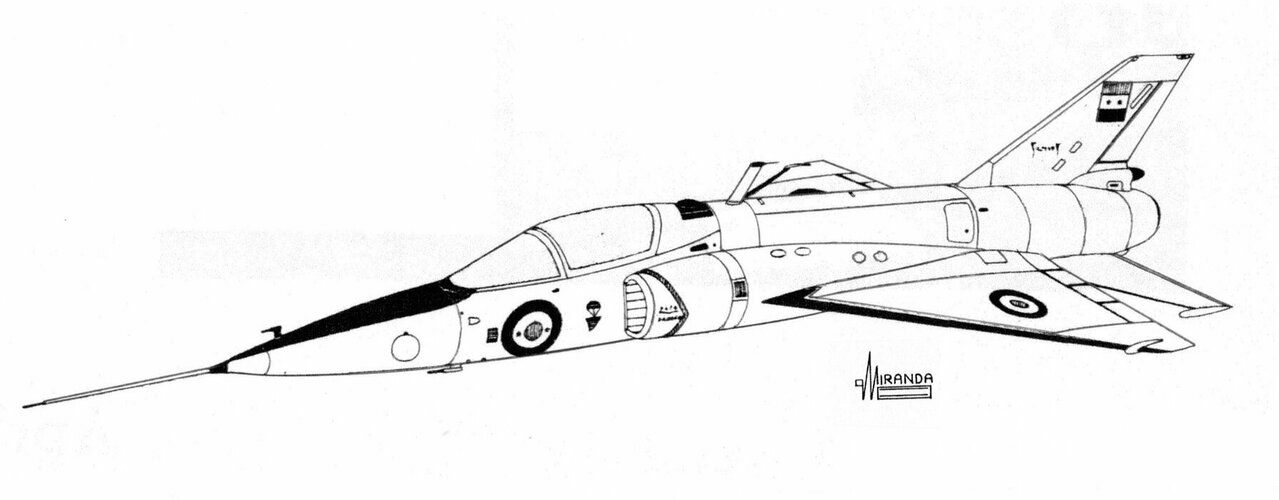You are using an out of date browser. It may not display this or other websites correctly.
You should upgrade or use an alternative browser.
You should upgrade or use an alternative browser.
Spanish/Egyptian HA-300 supersonic fighter project
Retrofit
ACCESS: Top Secret
- Joined
- 21 February 2007
- Messages
- 656
- Reaction score
- 336
Definitively a scale model.I have this photo from Cuatros Vientos Museum but I don't know if it is the original aircraft or just a (scale)-model.
Attachments
I believe that it was meant to use the Russian Vympel K-13 (NATO AA-2 Atoll) in Egyptian service.but what kind of air to air rockets will he use and will this plane have a radar?
hi i have a question what are the caracteristics of the hispano ha23P glider demonstrator (lenght,wingspan,height,ect...) if you have them please i searched but c ant find them.Re: Spanish/Egyptian HA-300 supersonic fighter project - post 2
Please find attached some additional info
Wingspan: 6.15 m.hi i have a question what are the caracteristics of the hispano ha23P glider demonstrator (lenght,wingspan,height,ect...) if you have them please i searched but c ant find them.Re: Spanish/Egyptian HA-300 supersonic fighter project - post 2
Please find attached some additional info
Lenght: 10.02 m.
Wing surface: 20 sq. m.
Max weight: 1,250 kg.
Attachments
thanksWingspan: 6.15 m.hi i have a question what are the caracteristics of the hispano ha23P glider demonstrator (lenght,wingspan,height,ect...) if you have them please i searched but c ant find them.Re: Spanish/Egyptian HA-300 supersonic fighter project - post 2
Please find attached some additional info
Lenght: 10.02 m.
Wing surface: 20 sq. m.
Max weight: 1,250 kg.
- Joined
- 26 May 2006
- Messages
- 34,810
- Reaction score
- 15,695
A question out of curiosity, did the HF-24 testbed for the E-300 fly in Indian or Egyptian markings?
It didn't carry Egypt mark of course.
I often wonder - why did the Marut / E-300 failed ? what was wrong with the combination ? A pity India didn't picked the slack with the E-300 past June 1969. Considering the fate of Kaveri, decades after.
Even more since E-300 derived from the NK-12, through Ferdinand Brandner and the TV-2 turbine... then the NK-12 was the engine of the Tu-126 and Tu-142... and India got both aircraft in the end (one Tu-126 in 1971 during the war with Pakistan, and a few Tu-142s: 1987-2017... )
Imagine, if Brandner had stuck a few more years, he could have returned to the E-300 roots via a Tu-126's NK-12s... what might have been.
But this is not a thread for speculation.
Even more since E-300 derived from the NK-12, through Ferdinand Brandner and the TV-2 turbine... then the NK-12 was the engine of the Tu-126 and Tu-142... and India got both aircraft in the end (one Tu-126 in 1971 during the war with Pakistan, and a few Tu-142s: 1987-2017... )
Imagine, if Brandner had stuck a few more years, he could have returned to the E-300 roots via a Tu-126's NK-12s... what might have been.
But this is not a thread for speculation.
- Joined
- 6 September 2006
- Messages
- 4,827
- Reaction score
- 9,414
During my researches on another topic I came across a letter by Sir Arnold Hall (chairman of Hawker Siddeley Aviation) following his visit to Egypt in February 1972. He was given a tour of the Helwan plant.
He states at that point the plant was basically making MiG-21 drop tanks. He describes it as "Its tools are rather out of date - the plant has gone to seed, though very large sums have been spent on it in the past.
The Soviets had offered a MiG-21MF licence but the EAF seemed reluctant to build them, wanting a fighter-bomber which the Soviets refused to supply.
He describes the engine shop as being more active but still of limited capability. He claims he was shown "two engines of their own" which he said looked like copies of a French and a Russian engine. Presumably these must have been one of the locally-built Marbores for HA-200 and the Brandner E-300 (Brandner had worked in the USSR before his release in 1953 so its possible this is why it seemed "Russian" to Hall?).
Hall goes on to claim only 35 HA-200s had been built (Flight a few years earlier had estimated 65, Wiki states 90 - not sure what the real figure is?)
Of the HA-300 he says "had never flown, but recent orders have been given to prepare it for flight." This must refer to the 3rd prototype as of course the first two prototypes had flown a decade earlier. Given that the HA-300 project was terminated in 1969 this resurgence of interest in early 1972 is interesting as is whether the engine was still the intended E-300 or something else.
He noted there seemed to be no provision for any armament.
Hall goes on to say "Discussions revealed that instructions had been given to adapt it to a fighter-bomber role, under the number Cairo-400 - the airframe seemed unsuitable for such adaptation. I think little progress had been made with this task."
I have not come across the Cairo-400 designation before (in his letter the Helwan aircraft are referred to as Cairo-200, Cairo-300 and Cairo-400) and this seems to be a little-known further development, probably one that was short-lived.
He states at that point the plant was basically making MiG-21 drop tanks. He describes it as "Its tools are rather out of date - the plant has gone to seed, though very large sums have been spent on it in the past.
The Soviets had offered a MiG-21MF licence but the EAF seemed reluctant to build them, wanting a fighter-bomber which the Soviets refused to supply.
He describes the engine shop as being more active but still of limited capability. He claims he was shown "two engines of their own" which he said looked like copies of a French and a Russian engine. Presumably these must have been one of the locally-built Marbores for HA-200 and the Brandner E-300 (Brandner had worked in the USSR before his release in 1953 so its possible this is why it seemed "Russian" to Hall?).
Hall goes on to claim only 35 HA-200s had been built (Flight a few years earlier had estimated 65, Wiki states 90 - not sure what the real figure is?)
Of the HA-300 he says "had never flown, but recent orders have been given to prepare it for flight." This must refer to the 3rd prototype as of course the first two prototypes had flown a decade earlier. Given that the HA-300 project was terminated in 1969 this resurgence of interest in early 1972 is interesting as is whether the engine was still the intended E-300 or something else.
He noted there seemed to be no provision for any armament.
Hall goes on to say "Discussions revealed that instructions had been given to adapt it to a fighter-bomber role, under the number Cairo-400 - the airframe seemed unsuitable for such adaptation. I think little progress had been made with this task."
I have not come across the Cairo-400 designation before (in his letter the Helwan aircraft are referred to as Cairo-200, Cairo-300 and Cairo-400) and this seems to be a little-known further development, probably one that was short-lived.
Last edited:
Me too, did a qui serch, found nothing. Must have been short lived. Still, browsing Google books I've found an interesting tidbit (see attached).
In 1975 Egypt and a few other Arab nations formed a big consortia called AOI - https://en.wikipedia.org/wiki/Arab_Organization_for_Industrialization
With 1979 Egypt truce with Israel it imploded, but Egypt carried on and by 1983 build its first Gazelle helicopter from kits. Looks closely at the attached excerpt of a french magazine (in yellow). Seems that, at the roll-out of the Gazelle, AOI (which had taken over the former E-300 jet engine plant at Helwan) showed an E-300 turbojet, split into its major components.
Heck I also found the Brandner E-300 detailed characteristics in Flight International, 1969.

In 1975 Egypt and a few other Arab nations formed a big consortia called AOI - https://en.wikipedia.org/wiki/Arab_Organization_for_Industrialization
With 1979 Egypt truce with Israel it imploded, but Egypt carried on and by 1983 build its first Gazelle helicopter from kits. Looks closely at the attached excerpt of a french magazine (in yellow). Seems that, at the roll-out of the Gazelle, AOI (which had taken over the former E-300 jet engine plant at Helwan) showed an E-300 turbojet, split into its major components.
Heck I also found the Brandner E-300 detailed characteristics in Flight International, 1969.
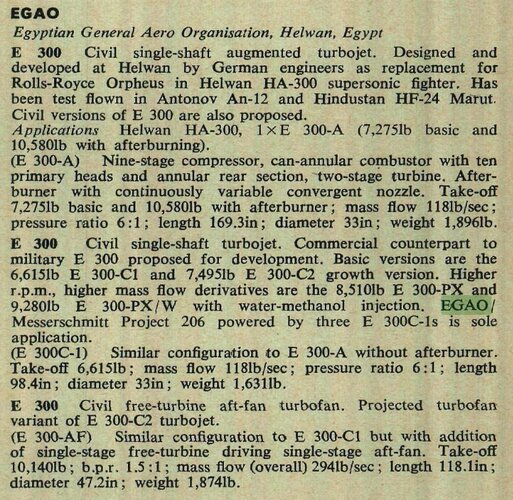
Attachments
Last edited:
Dear Toryu, do you know where I can get this photo? Do you know the location where it was made? Kind regards BernardSecond prototipe or model?
- Joined
- 3 September 2006
- Messages
- 1,473
- Reaction score
- 1,463
There were 3 HA-300 built. The first prototype is at Deutsches Museum Flugwerft at Oberschleißheim near Munich.do you know where I can get this photo? Do you know the location where it was made?
The other two HA-300 are displayed at Messerschmitt Stiftung in Manching, and at the Air Force Museum in Cairo.
Dear Toryu, do you know where I can get this photo? Do you know the location where it was made? Kind regards Bernard
The truth is, I think it is fortunate that the three prototypes are preserved. Although I need to see photos of one of them. I also wonder what the instrument panel would be like on the stock airplanes. Clearly the two panels I have seenThere were 3 HA-300 built. The first prototype is at Deutsches Museum Flugwerft at Oberschleißheim near Munich.
The other two HA-300 are displayed at Messerschmitt Stiftung in Manching, and at the Air Force Museum in Cairo.
correspond to prototypes, without radar screen and with indicators reduced to a minimum.
Attachments
The one HA-300 which was on display at the "Flugwerft Schleissheim" was transfered to "Flugmuseum Messerschmitt" in Manching, in in 2015. It is now mentioned on their website, but it appears the shown "Lebenslauf" refers to a different aircraft: https://www.flugmuseum-messerschmitt.de/FLUGZEUGE-UND-CREW/HA-300/index.php
There is no second HA-300 in Germany. Another HA-300 is in the Air Force Museum in Cairo... and the third prototype seems to be still in the Helwan factory, not accessible for the public.
There is no second HA-300 in Germany. Another HA-300 is in the Air Force Museum in Cairo... and the third prototype seems to be still in the Helwan factory, not accessible for the public.
- Joined
- 8 January 2006
- Messages
- 1,608
- Reaction score
- 754
From what I've read, the third prototype was to have been fitted with an afterburning E300 as well as variable centerbody intakes. I'm looking at how to modify A&A's kit to represent this aircraft.
- Joined
- 26 May 2006
- Messages
- 34,810
- Reaction score
- 15,695
Hall goes on to say "Discussions revealed that instructions had been given to adapt it to a fighter-bomber role, under the number Cairo-400 - the airframe seemed unsuitable for such adaptation. I think little progress had been made with this task."
I have not come across the Cairo-400 designation before (in his letter the Helwan aircraft are referred to as Cairo-200, Cairo-300 and Cairo-400) and this seems to be a little-known further development, probably one that was short-lived.
Maybe it had a twin engine ?.
- Joined
- 25 July 2007
- Messages
- 4,297
- Reaction score
- 4,183
... I have not come across the Cairo-400 designation before (in his letter the Helwan aircraft are referred to as Cairo-200, Cairo-300 and Cairo-400) and this seems to be a little-known further development, probably one that was short-lived.
Since Hood's post has re-emerged, perhaps worth mentioning that 'Cairo' in this context is usually rendered as Al-Qahira.
- Joined
- 6 September 2006
- Messages
- 4,827
- Reaction score
- 9,414
Thankyou for that additional info.Since Hood's post has re-emerged, perhaps worth mentioning that 'Cairo' in this context is usually rendered as Al-Qahira.
(I should add, I was quoting Hall's memo, so no surprise its Anglicised.)
No idea. No detail is offered in Hall's document. I would think if it was a relatively basic HA-300 conversion, then it wouldn't be - but whether it was planned to have the E300 or another engine, again I don't know.Maybe it had a twin engine ?.
- Joined
- 26 May 2006
- Messages
- 34,810
- Reaction score
- 15,695
Hi,

 army.alafdal.net
army.alafdal.net

حلوان 300 لماذا وصلت المتحف؟
عندما كنت جالس مع احد افراد وحدة 39 قتال من فترة 1969 الى 1973 وكان قبلها احد افراد الجيش في ميدان التحرير من ثلاث اسابيع تحدث معي انا واصدقائي عن تطوير و اخ
 army.alafdal.net
army.alafdal.net
Attachments
Design of the HA-300 supersonic fighter began in July 1953 based on the Messerschmitt P 1111 wartime project. In June 1954 the first aerodynamic tests were carried out with a tailless wind tunnel model with 58-degrees swept wing.
The model proved to be unstable, and it was decided to modify the original design with the addition of a swept tailplane.
In the P300/S28 configuration proposed on October 28, 1954, the tailplane was mounted on the rear section of the fuselage.
In the P300/WN045 configuration (November 1954), the tailplane was mounted on the tailfin and the air intakes had been redesigned with 50-degrees forward swept configuration based on those of the Republic F-105 Thunderchief.
Messerschmitt/Hispano Aviacion HA-300 (October 28, 1954) technical data
Wingspan: 7.4 m. Length: 13.11 m. Height: 3.45 m. Wing Area: 24.62 sq. m. Max weight: 5,000 kg. Max speed: 1,400 km/h. Power plant: one SNECMA Atar 101 E turbojet rated at 3,500 kg static thrust. Armament: two 20-mm Oerlikon cannons and 24x75-mm Oerlikon rockets.
During the autumn of 1955 Prof. Messerschmitt decided to modify the project, eliminating 34 per cent of the weight, to compete with the Heinkel C-101 light jet fighter proposed by Siegfried Günther on June 30, 1955.
The new HA-300 (P300/K058) was redesigned in delta configuration, with 58-degrees swept at the leading edge, 1.9 aspect ratio and 3% thickness.
The aircraft was to be powered by a Bristol Orpheus turbojet and armed only with two 30-mm Hispano Suiza cannons.
A schematic of K058 was published in Aviation Week (April 22, 1957) under the designation Messerschmitt XC-6.
Messerschmitt/Hispano Aviacion HA-300 (P300/K058) March 7, 1956 technical data
Wingspan: 5.6 m. Length: 13.5 m. Height: 3 m. Wing Area: 17 sq. m. Max weight: 3,285 kg. Max speed: 1,360 km/h. Power plant: one Bristol BOr.3 Orpheus 801 turbojet rated at 2,200 kg static thrust. Range 500 km. Armament: two 30-mm Hispano Suiza cannons. Pressurized cockpit with ejector seat Martin-Baker Mk. 4.
Some wind tunnel performed early in 1958 in Grainau and EFW Emmen brought doubts about the K058 stability.
In order to evaluate the low-level flight characteristics of the delta fighter, a full-scale glider HA-23P of mixed construction had been built in May 1959. The glider flew on 25 June, with 500 kg of water ballast, towed by a Heinkel/CASA C-2111 bomber and proved so dangerously unstable that the test pilot refused to fly it again.
The HA-300 supersonic fighter project was cancelled by the Ministerio del Aire on September 24, 1959.
HA-23P glider technical data
Wingspan: 6.15 m. Length: 10.02 m. Height: 3.17 m. Wing Area: 20 sq. m. Max weight: 1,250 kg. Anti-spin brake-parachute housed into the tail cone. Fixed landing gear from a HA-100 trainer.
At the end of 1959 the HA-300 program was transferred to Egypt.
The commercial transaction included all the project documentation, the manufactured parts of the first prototype 23/I (XC-6-1), two wind tunnel models built at 1:3 scale and the HA-23 P glider.
Prototype 23/I (XC-6-1) technical data
Wingspan: 5.84 m. Length: 11.10 m. Height: 3.08 m. Wing Area: 17.12 sq. m. Max weight: 3,700 kg. Max speed: Mach 2. Power plant: one Bristol BOr.12 SR Orpheus turbojet rated at 3,090 kg static thrust and 3,630 with afterburner. Armament: two 30-mm Hispano Suiza cannons and two air-to-air missiles Sidewinder. Pressurized cockpit with ejector seat Martin-Baker Mk. 4. Electronics: Ferranti gyroscopic gunsight, ANPX-6 radar, IFF.
In 1960, Egyptian production of the HA-200 and construction of prototypes of the HA-300 began at factories No. 36 and No. 135 located in Cairo-Helwan. On June 5, 1967, both factories were attacked by four Israeli Mirages and two Vautours which destroyed two HA-200s, three MiG-17s, one MiG-19 and damaged one Antonov An-12.
After the failure of the HA-23 P glider in Spain, Professor Messerschmitt did not allow it to fly again. He also modified the XC-6 by bringing back the original 40-degree tailplane of the P300/S028.
Unfortunately for the Egyptians, production of the Orpheus 12 turbojet had been cancelled by the British in 1959.
In the spring of 1960, Messerschmitt suggested hiring engineer Ferdinand Brandner to handle the production of the E-200 turbojet (the Egyptian version of the Marbore II) to power the HA-200 trainer.
It was hoped that Brandner's team would be able to develop a turbojet equivalent to the Orpheus within a reasonable timeframe.
The first engine, designated E-300-A, underwent static testing in July 1963 and was flight tested in June 1966, suspended under the port wing of an Antonov An-12B.
A total of 17 E-300-A engines with 3,300 kg static thrust and fully variable afterburner were manufactured.
Three prototypes of the HA-300 supersonic fighter were also built: the HA-300-001 was flown on March 7, 1964 powered by one Bristol Orpheus 703 S-10 turbojet. The HA-300-002 flew on July 22, 1965 powered by the same engine.
The HA-300-003 was only taxi tests, powered by one E-300-A turbojet, before the program was cancelled in November of 1969.
Helwan/EGAO HA-300-001 technical data.
Wingspan: 5.84 m. Length: 11.75 m. Height: 3.65 m. Wing Area: 16.7 sq. m. Max weight: 3,200 kg. Max speed: Mach 1.3. Range: 1,400 km. Service ceiling: 18,000 m. Power plant: one Bristol Orpheus 703 S-10 turbojet rated at 2,200 kg static thrust.
The model proved to be unstable, and it was decided to modify the original design with the addition of a swept tailplane.
In the P300/S28 configuration proposed on October 28, 1954, the tailplane was mounted on the rear section of the fuselage.
In the P300/WN045 configuration (November 1954), the tailplane was mounted on the tailfin and the air intakes had been redesigned with 50-degrees forward swept configuration based on those of the Republic F-105 Thunderchief.
Messerschmitt/Hispano Aviacion HA-300 (October 28, 1954) technical data
Wingspan: 7.4 m. Length: 13.11 m. Height: 3.45 m. Wing Area: 24.62 sq. m. Max weight: 5,000 kg. Max speed: 1,400 km/h. Power plant: one SNECMA Atar 101 E turbojet rated at 3,500 kg static thrust. Armament: two 20-mm Oerlikon cannons and 24x75-mm Oerlikon rockets.
During the autumn of 1955 Prof. Messerschmitt decided to modify the project, eliminating 34 per cent of the weight, to compete with the Heinkel C-101 light jet fighter proposed by Siegfried Günther on June 30, 1955.
The new HA-300 (P300/K058) was redesigned in delta configuration, with 58-degrees swept at the leading edge, 1.9 aspect ratio and 3% thickness.
The aircraft was to be powered by a Bristol Orpheus turbojet and armed only with two 30-mm Hispano Suiza cannons.
A schematic of K058 was published in Aviation Week (April 22, 1957) under the designation Messerschmitt XC-6.
Messerschmitt/Hispano Aviacion HA-300 (P300/K058) March 7, 1956 technical data
Wingspan: 5.6 m. Length: 13.5 m. Height: 3 m. Wing Area: 17 sq. m. Max weight: 3,285 kg. Max speed: 1,360 km/h. Power plant: one Bristol BOr.3 Orpheus 801 turbojet rated at 2,200 kg static thrust. Range 500 km. Armament: two 30-mm Hispano Suiza cannons. Pressurized cockpit with ejector seat Martin-Baker Mk. 4.
Some wind tunnel performed early in 1958 in Grainau and EFW Emmen brought doubts about the K058 stability.
In order to evaluate the low-level flight characteristics of the delta fighter, a full-scale glider HA-23P of mixed construction had been built in May 1959. The glider flew on 25 June, with 500 kg of water ballast, towed by a Heinkel/CASA C-2111 bomber and proved so dangerously unstable that the test pilot refused to fly it again.
The HA-300 supersonic fighter project was cancelled by the Ministerio del Aire on September 24, 1959.
HA-23P glider technical data
Wingspan: 6.15 m. Length: 10.02 m. Height: 3.17 m. Wing Area: 20 sq. m. Max weight: 1,250 kg. Anti-spin brake-parachute housed into the tail cone. Fixed landing gear from a HA-100 trainer.
At the end of 1959 the HA-300 program was transferred to Egypt.
The commercial transaction included all the project documentation, the manufactured parts of the first prototype 23/I (XC-6-1), two wind tunnel models built at 1:3 scale and the HA-23 P glider.
Prototype 23/I (XC-6-1) technical data
Wingspan: 5.84 m. Length: 11.10 m. Height: 3.08 m. Wing Area: 17.12 sq. m. Max weight: 3,700 kg. Max speed: Mach 2. Power plant: one Bristol BOr.12 SR Orpheus turbojet rated at 3,090 kg static thrust and 3,630 with afterburner. Armament: two 30-mm Hispano Suiza cannons and two air-to-air missiles Sidewinder. Pressurized cockpit with ejector seat Martin-Baker Mk. 4. Electronics: Ferranti gyroscopic gunsight, ANPX-6 radar, IFF.
In 1960, Egyptian production of the HA-200 and construction of prototypes of the HA-300 began at factories No. 36 and No. 135 located in Cairo-Helwan. On June 5, 1967, both factories were attacked by four Israeli Mirages and two Vautours which destroyed two HA-200s, three MiG-17s, one MiG-19 and damaged one Antonov An-12.
After the failure of the HA-23 P glider in Spain, Professor Messerschmitt did not allow it to fly again. He also modified the XC-6 by bringing back the original 40-degree tailplane of the P300/S028.
Unfortunately for the Egyptians, production of the Orpheus 12 turbojet had been cancelled by the British in 1959.
In the spring of 1960, Messerschmitt suggested hiring engineer Ferdinand Brandner to handle the production of the E-200 turbojet (the Egyptian version of the Marbore II) to power the HA-200 trainer.
It was hoped that Brandner's team would be able to develop a turbojet equivalent to the Orpheus within a reasonable timeframe.
The first engine, designated E-300-A, underwent static testing in July 1963 and was flight tested in June 1966, suspended under the port wing of an Antonov An-12B.
A total of 17 E-300-A engines with 3,300 kg static thrust and fully variable afterburner were manufactured.
Three prototypes of the HA-300 supersonic fighter were also built: the HA-300-001 was flown on March 7, 1964 powered by one Bristol Orpheus 703 S-10 turbojet. The HA-300-002 flew on July 22, 1965 powered by the same engine.
The HA-300-003 was only taxi tests, powered by one E-300-A turbojet, before the program was cancelled in November of 1969.
Helwan/EGAO HA-300-001 technical data.
Wingspan: 5.84 m. Length: 11.75 m. Height: 3.65 m. Wing Area: 16.7 sq. m. Max weight: 3,200 kg. Max speed: Mach 1.3. Range: 1,400 km. Service ceiling: 18,000 m. Power plant: one Bristol Orpheus 703 S-10 turbojet rated at 2,200 kg static thrust.
Attachments
apparition13
I really should change my personal text
- Joined
- 27 January 2017
- Messages
- 604
- Reaction score
- 1,101
The (I'm assuming estimated) performance chart is very interesting.
The Brandner300 would increase thrust to weight to better than 1:1. Combined with the wing loading I can see Boyd salivating over it. It would be superior to both the MiG-21 and F-5 in the dogfight.
The range is decent, but does that include time at afterburner? Or 5 minutes at mil, like US Navy SACs do? If not, what kind of combat range would we be looking at with time at mil and/or afterburner?
Did the Brandner have significantly better SFC estimated? If not, range and endurance would suffer.
Max mach is estimated 2.0, but 1.7 was the actual with the Orpheus, at least according to wiki. 2.0 was the estimate with the Brandner.
I wonder, what kind of ground attack capability would it have had in a pre-Maverick world?
The Brandner300 would increase thrust to weight to better than 1:1. Combined with the wing loading I can see Boyd salivating over it. It would be superior to both the MiG-21 and F-5 in the dogfight.
The range is decent, but does that include time at afterburner? Or 5 minutes at mil, like US Navy SACs do? If not, what kind of combat range would we be looking at with time at mil and/or afterburner?
Did the Brandner have significantly better SFC estimated? If not, range and endurance would suffer.
Max mach is estimated 2.0, but 1.7 was the actual with the Orpheus, at least according to wiki. 2.0 was the estimate with the Brandner.
I wonder, what kind of ground attack capability would it have had in a pre-Maverick world?
Impressive. And a pity India did not took over that program.A total of 17 E-300-A engines with 3,300 kg static thrust and fully variable afterburner were manufactured.
Similar threads
-
-
-
Lockheed CL-1200 / X-27 Lancer
- Started by overscan (PaulMM)
- Replies: 84
-


